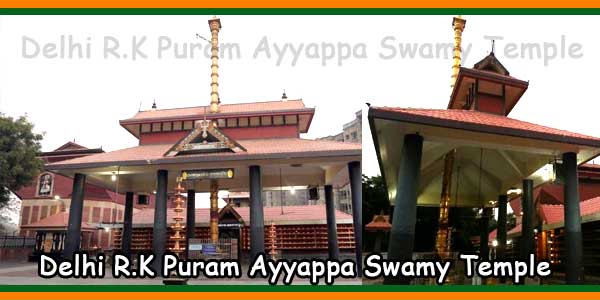R.K Puram Ayyappa Swamy Temple Timings:
Normal Days & During Mandalam:
Morning: 5:30 AM to 11:00 AM
Evening: 5:30 PM to 8:30 PM
R.K Puram Ayyappa Swamy Temple Daily:
During Brahma Muhurtham – Palli Unarthal
5:30 AM – Nirmalya Darshanam
5:30 AM – Ganapathi Homam
6:00 AM – Abhishekam, Malar Nivedyam, and Usha Pooja
7:00 AM – Ethirattu Pooja (Prabhatha pooja). Followed by Shiveli
9:00 AM – Pantheeradi Pooja
10:00 AM – Uccha Pooja followed by Shiveli
11:00 AM – Closing time
5:30 PM – Temple re-opens for public Darshanam.
6:30 PM to 7:00 PM – Deeparadhana (time keep changing according to sunset)
7:30 PM to 8:25 PM – Athazha Pooja followed by Athazha Shiveli
8:30 PM – Harivarasanam (closing Time: 8:30 PM)
R.K Puram Ayyappa Swamy Temple History:
It was in the year 1971, a group of Ayyappa devotees joined together in R.K.Puram and assumed a community form and started conducting community pujas, bhajans, kirtans, Ayyappan Pattu (songs in a style praising the Lord in a traditional manner) on a regular basis. As a sequel, the Ayyappa Pooja Samithi took birth in 1973. Slowly and steadily the Samithi gained popularity and on 10th May 1973, it became a registered body. Since then, the devotees cherished a heartfelt yearning to set up at least a Balalayam (a small modest adobe), if not a sacred shrine, for worshiping the Lord. A Committee, an ad-hoc body, was formed for this purpose and without waiting long, it manifested in the month of June 1973 in Sector-3 near the DDA flats adjacent to Munirka on Government Land. Worship started with Pujas before a portrait of the Lord. Soon, this improvised hut of the Lord turned into a shrine, attracting a swelling number of devotees from all over Delhi. His Holiness Sri Jayendra Saraswati Swamikal of the famous Kanchi Kamakoti Peetom visited this Ayyappa Shrine which was indeed an auspicious event. He blessed the devotees who initiated this venture. Pujas, rituals, community, bhajans all went on uninterrupted. A pujari (priest) from Kerala took over the charges of Pujas and Rituals so as to conform to the pujas in Kerala style of observance.

As the divine scheme began unfolding, Jagadguru Sri Sankaracharya of Joshimath, Santhananda Saraswati of Bhadrikashram visited the newly allotted site and performed the Bhoomi-puja (rites for purification and consecration of the land). Following this, the Sthala-Prasnam (astrological reckoning did on the spot) and Devaprasnam (for determining divine favor or sanction) were performed by Brahmashri Kaimukku Parameswaran Thantri, an expert in astrology, and accordingly, a Balalayam was built. With this, the sacred adobe of the deity was transferred from the earlier sanctum in sector-3, with due ceremonies for transmitting the ‘divinity’ into the new idol. The idol was made of Panchaloha, five metal. The ceremonies were supervised, among others, by Brahmasri Panavur Diwakaran Namboothiri.
The construction of a larger Shrine then started and went on in accordance with the Chera style of temple architecture followed in Kerala. Brahmasri Kanipayur Krishnan Namboothiri under the guidance of his father and guru revered Brahmasri Kanippayur Sankaran Namboothiri prepared the plan for the structure. It took two years’ work of 25 sculptors in Kerala and further time in Delhi to complete the stone and sculpturing work. The stones were those collected from the banks of the sacred river, Bharathapuzha, the historic and hallowed spot of Tirunavaya in Kerala. Prominent among the sculptors was Shri Sankarankutty from Ottappalam. Shri Waderkar (Delhi) was the architect and Shri Sharma-ji (Delhi) was the contractor of this Temple.
Finally, the construction work was completed and the consecration ceremony took place on 30th April 1980(Malayalam month Medam, Nakshatram -”Chothi”) – a day when the star Swati ruled. Revered Thantri Ambalapuzha Bhramashri Puthumana N.Damodaran Namboothiri conducted the consecration ceremony. Nagarcoil Pattan Asari had carved the idol, a creation of exquisite beauty and joy. The pujas and rituals now being observed, continue to conform strictly to the charthu (prescription) made by the Thantri. The present Thantri Brahmashri Puthumana D.Sreedharan Namboothiri his son.
Thousands of Lord Ayyappa devotees whole-heartedly contributed their might by way of performing physical labor, through financial assistance and organizational skill during the process of construction of this Temple. It must be remembered that without God’s grace and those far-sighted devotees’ sacrifice, efforts and contribution, this Temple would not have become a “Mahakshetra”-that it is today.
Bhadrakali Temple and Chithrakudam for Nagas:
In accordance with the Devaprasnam held in the month of October 2005, the Samithi also constructed a Goddess Durga (Bhadrakali) and Sarpa Kavu for Nagas (with the installation of Nagaraja, Naga Yakshi and a Chithrakuda, representing all snakes). While the Naga Prathishta (consecration ceremony) was conducted on 9th February 2006, the Bhadrakali Prathishta was performed on 10th February 2006).
Delhi Ayyappa Swamy Temple:
Ayyappa Sewa Samithi,
Ayyappa Mandir Marg,
Sector – 2,
R.K Puram,
New Delhi – 110022.
Phone – 011-26171962, 26191129
E-Mail: ayyappa.rkp@gmail.com

